| 1 | Painted bronzeback |
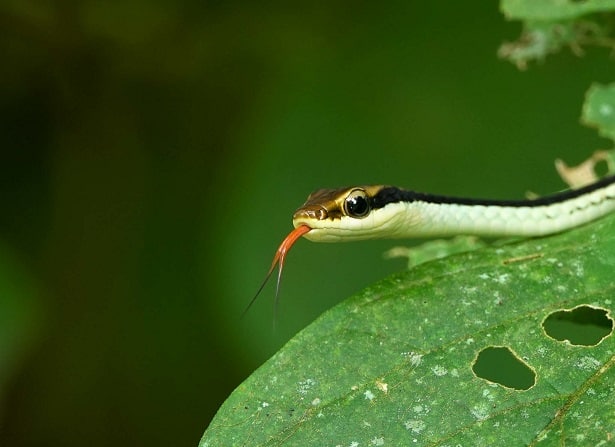
Tongue: bright red.
This Thai and Malaysian snake has a purely red tongue, with no fancy gimmicks. The painted bronzeback is totally harmless to humans, and reaches a maximum of 120cm. This is one of Thailand and Singapore’s most common snakes, inhabiting every corner of both nations.
Painted bronzebacks can stay incredibly still on their leafy branches, with the only indication they’re not dead being a slightly inflating and deflating chest. Every so often, they’ll fleck their red tongues as well, or perhaps they won’t. Unlike the tongue, their body doesn’t have a single hint of red. This species has a cream-coloured belly, with a green-brown back.
Painted bronzebacks prey on frogs, with one species being the Asian rice frog (Fejervarya limnocharis). They also eat lizards such as Brooke’s house gecko. Their flecking red tongue isn’t designed to look menacing, but to detect prey scents, carried on the winds or lingering on objects like logs. Their tongue might also help them to detect a deadly predator: the Javan spitting cobra, which is confirmed to eat them.
Close relatives: the Dendrelaphis bronzeback genus is huge, with at least 50 members. The Burmese bronzeback of Vietnam has an oily black tongue, while the saw-tooth necked bronzeback is another with a red tongue. Red is more common than not with bronzebacks.
| 2 | Spotted bush snake |
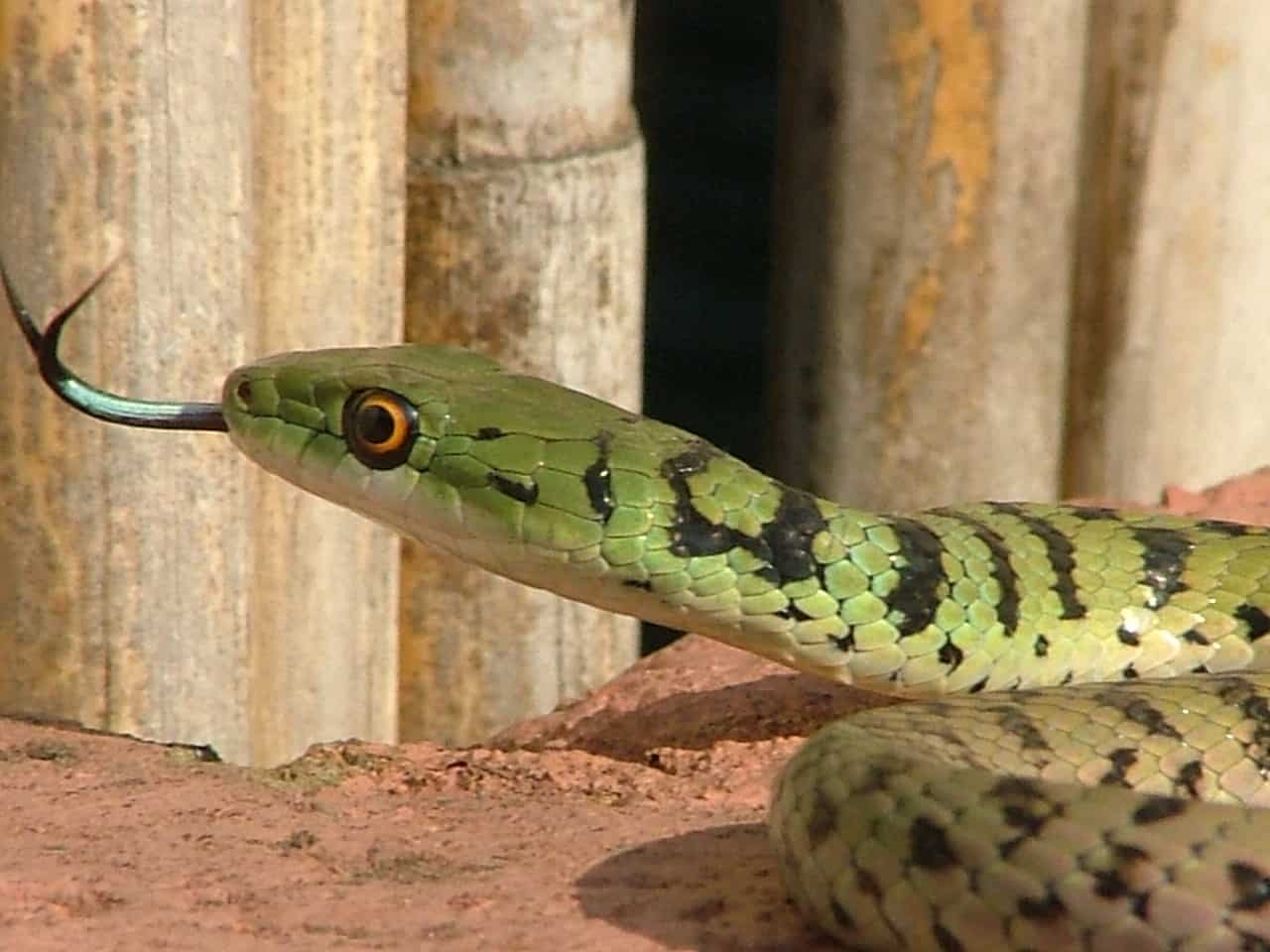
Tongue: green.
A common species in the southern half of Africa. The spotted bush snake (Philothamnus semivariegatus) lives from South Africa in the south, all the way to Tanzania and Kenya. They reach a record length of 140.5cm, with an average of 90cm.
Their bodies contain the following colours: green, cream and black, but it’s green that clearly dominates. This includes their forked tongue, poking out of their mouth and flecking inquisitively, examining any slightly interesting object they come across.
The spotted bush snake is mainly a savannah species, but also inhabits tree clumps on the edges of agricultural fields. Bush snake is an accurate name, as Philothamnus semivariegatus rarely climbs high trees, but is common on thorny bushes 1 metre above ground. This species balances on precipitous branches like a pro, as well as manmade wooden fences, and moves exclusively by day.
Even the spotted bush snake’s eyes are mostly green, as they have a large round pupil, surrounded by an avocado-coloured ring. The rest of their eye is a darker jungle green.
Close relatives: the common bush snake (Philothamnus irregularis) has a bright blue tongue, sharply divided with black forks lower down. This species is common in west African countries such as Sierra Leone.
| 3 | Siamese peninsular pitviper |
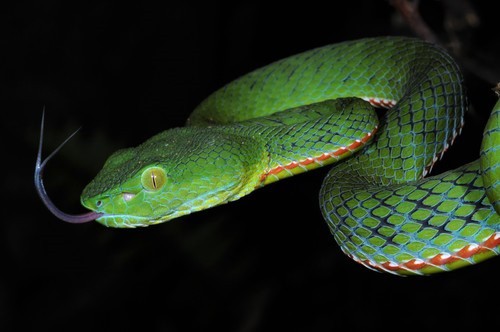
Tongue: purple, ends at blue.
This southeast Asian pitviper really can’t decide on its colours. It’s mainly green, but with a vivid red stripe down its flanks. There’s blue-black cracks visible between its scales, and also the occasional white dot on the red line. Its tongue, meanwhile, is a mixture of dense purple and blue.
Trimeresurus fucatus lives in southern Thailand and peninsular Malaysia, and is particularly common on the island of Pulau Langkawi. They love to rest on branches, and have densely coloured scales that barely reflect a camera’s flash. Some believe that fucatus means “with make up” in Latin, referencing their colourful face.
This species is venomous like all Trimeresurus pitvipers, but the exact qualities are unresearched. The Trimeresurus clan is generally cytotoxic, tearing through skin tissue with aplomb, but without being neurotoxic. Either way, the Siamese peninsular pitviper is undoubtedly dangerous, and its rich blue tongue should only be viewed from a distance. This is a moderate to small pitviper, with a record of just 86cm.
Close relatives: the white lipped pitviper is the most common Trimeresurus member, with plentiful populations in Bangkok and the whole of Thailand. This version also has a purple tongue, but sometimes near black.
| 4 | California red-sided garter snake |
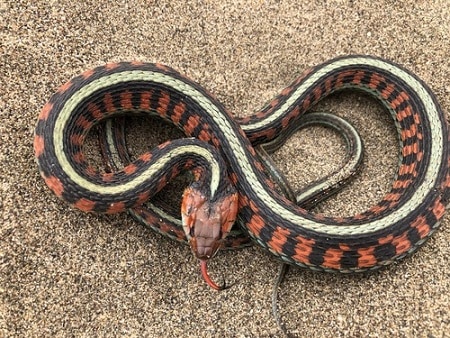
Tongue: red with a black tip.
Thamnophis sirtalis infernalis is one of the most spectacular of all garter snakes. Technically, it’s a mere subspecies of the common garter snake (found in 47 of 50 states), yet is far more vivid than the rest. It has a bright blue stripe down its spine, and bright red patterns on each flank. The redness extends fully to the head, while its belly is bright blue. These colours have led to a wild popularity in captivity.
The California red-sided garter snake reaches a maximum of 106cm, and only grows more colourful with age. The only area where it isn’t more fabulous than its kin is its tongue. As with all common garters, this tongue is bright red, with a jet black finish that kicks in just before the fork split.
Rather than constantly flecking, garter snakes tend to fleck their tongue for less than a second at once, separated by intervals of 3 to 4 seconds (see this video).
Close relatives: a red tongue with a black tip is found in virtually all garter snake species. This includes the giant garter snake of California, terrestrial garter snake of high altitudes, and eastern ribbon snake of Pennsylvania.
| 5 | Asian vine snake (morph) |
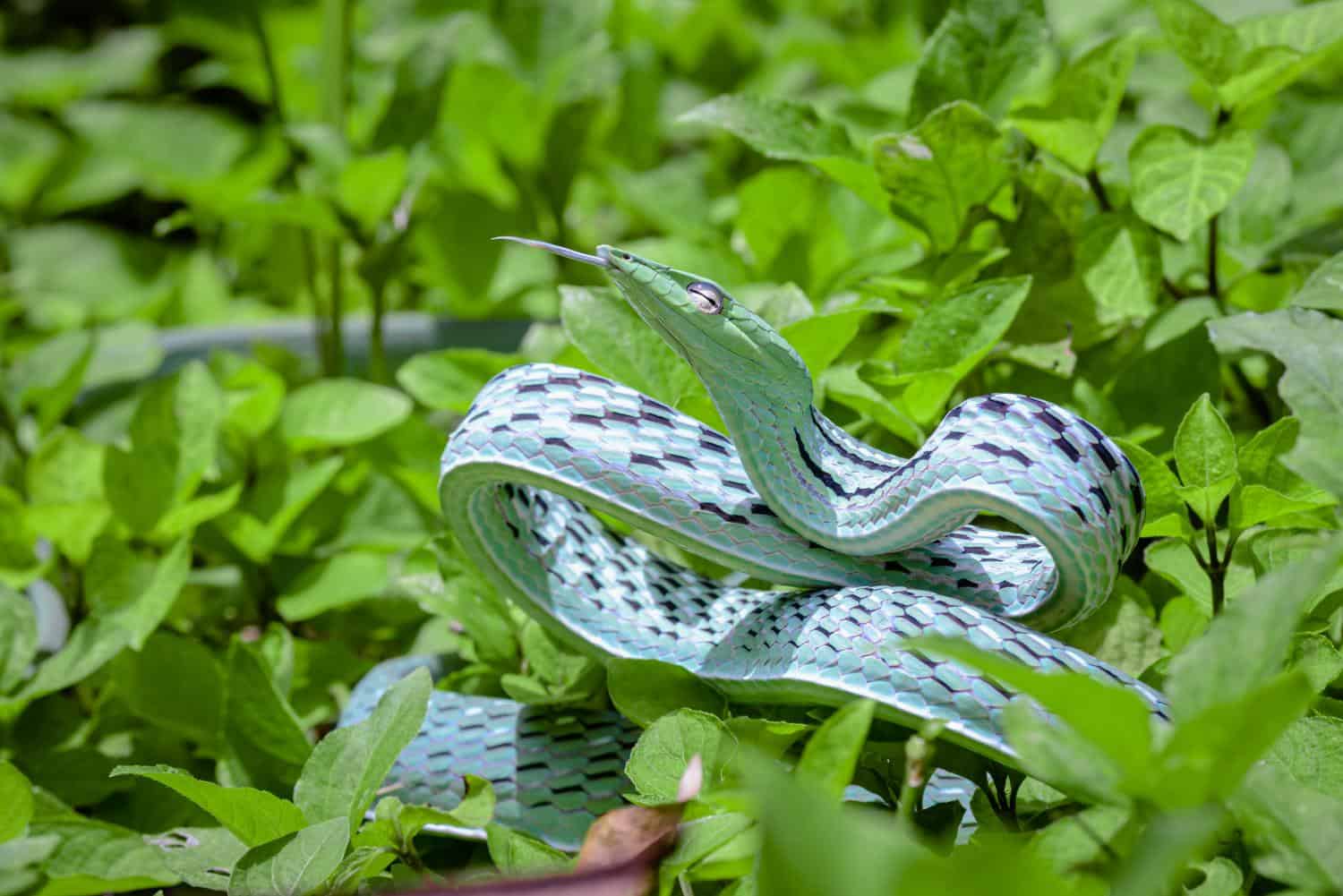
Tongue: silver.
A common resident of Thailand, Cambodia and Vietnam, with a maximum length of 197cm. With its keyhole-shaped pupils and pointy snout, the Asian vine snake is one of the strangest-looking snakes on Earth. They constantly appear in weird internet compilations, but a less known fact is their huge number of colour morphs.
For example, the silvery picture above was taken in Tat Mok National Park, located in central Thailand, 200 miles north of Bangkok. This silvery picture was taken in Khao Yai National Park, 80 miles east of Bangkok. Some areas barely have the normal green morph at all. A 2017 study found that in the Sakaeret Biosphere Reserve of Thailand’s north, 54% were silver and 46% were orange.
The interesting thing is that the tongue colour sticks to the overall body like velcro – an orange Asian vine snake will have an orange tongue, and so on. Consequently, this is a rare species to occasionally have a silver tongue, which looks like it would be in mortal peril if it ever decided to lick a magnet.
Close relatives: the Malayan whipsnake, resident of southern Thailand, has a green-yellow tongue instead. But its body is also yellow-green, and the tongue could easily vary with morphs just like its cousin.
| 6 | Red-tailed green ratsnake |
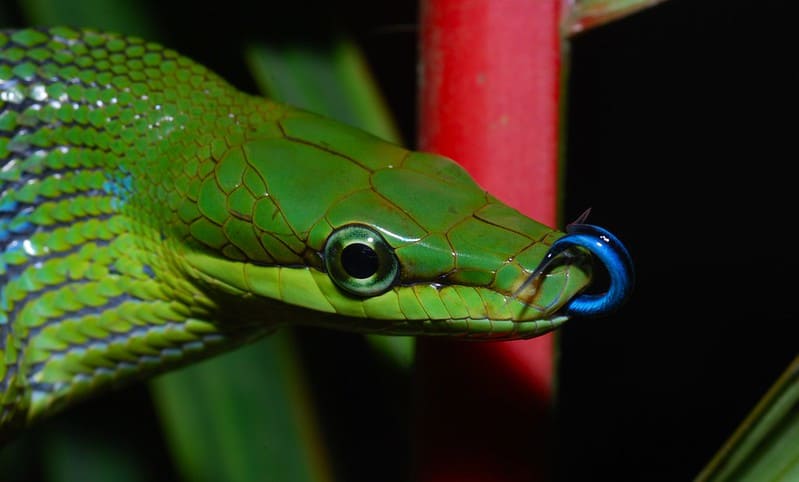
Tongue: blue with a black stripe.
A citizen of southeast Asia, first discovered in 1827. This snake runs through the full repertoire of jungle colours. Its tail is red, hence the alternative name of “red-tailed racer”. Its belly is a mild cream, while its main body is green. Then you reach the eyes, which have some blue tinges. Finally, the red-tailed ratsnake opens its mouth, and you are blasted with the most vivid blue tongue of any snake alive.
This species regularly reaches 2 metres, with a maximum length of 2.4 metres, and lives in trees all year round, sometimes stashing themselves in hollow trunks. Inspecting this tongue up close isn’t recommended. Gonyosoma oxycephalum is non-venomous, but highly aggressive, and might snap down on your nose as you peer forward curiously. The other risk is that they live in dense jungles, and to find one, you may have to fight your way through crocodiles and hissing pitvipers.
Close relatives: the Gonyosoma genus is also home to the rhinocerus ratsnake (Gonyosoma boulengeri), one of the weirdest snakes alive. Yet this Chinese and Vietnamese species has a mere pink tongue instead – all its weirdness points are concentrated in its sharp horn.
| 7 | Puerto Rican boa |
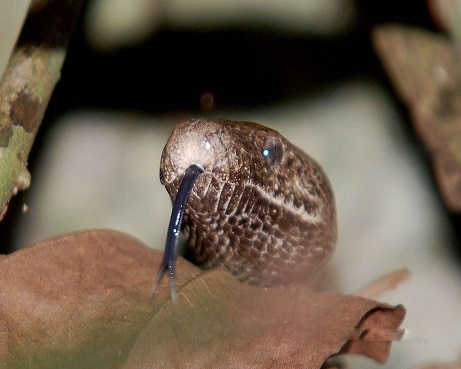
Tongue: black with a slightly paler tip.
Puerto Rican boas aren’t the most colourful boa worldwide. Their Latin name of Chilabothrus inornatus literally means without decoration, and this extends to their tongue, which is a pure oily black. The exception is the very tip, which is light grey. This almost perfectly matches their murky grey body patterns.
Unlike the Jamaican boa, which has golden yellow scales, Puerto Rican boas are nothing but black and white. At a distance, they’re a smothering black, while up close, subtle white cracks and lines manifest. Puerto Rican boas use their tongues to track down their favourite meal: bats roosting in caves, whether at the dark entrances or 20 metres deeper inside. It’s possible that their murkier shades evolved to prevent them from standing out inside these caves.
Puerto Rican boas reach a maximum of 2.7 metres, and are found solely on their namesake island, particularly in moist karst regions. The flecking tongue delivers scents to the Jacobson’s organ for further analysis, creating a far more powerful smelling sense than any recorded in human history, unless there was a caveman tribe with freakish powers that we don’t know about.
Close relatives: The Hispaniola boa of the Dominican Republic has a similar tongue, but the white has grown to cover a larger area, forcing the black into retreat.
| 8 | Northern Pacific rattlesnake |
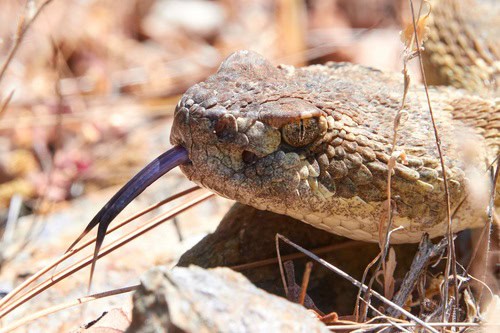
Tongue: violet with a black tip.
Pacific rattlesnakes are a fact of life for citizens of Washington, Oregon and California, although downtown LA is probably just about safe. Crotalus oreganus has a bite which can devastate skin tissue, but equally horrifying is that their tongue is a pure, alien purple.
Pacific rattlesnakes measure up to 162.6cm, and have a strongly myotoxic venom, targeting muscle tissue. Their purple tongue doesn’t contain these toxins, although given its funky colour, we wouldn’t be surprised. They look like they’ve been drinking from a polluted river next to an industrial factory, but the tongue colour is perfectly natural.
Pacific rattlesnakes are also recognisable by a black stripe starting just behind their eye. The rattle has up to 11 segments, and is a standard colour for the group: yellow-beige. Their eyes are orange, with a vicious vertical pupil, although it’s perfectly possible that they just wish to be friends with voles and mice instead, and are sick of their evil appearance excluding them. This species also inhabits British Columbia, southwest Canada.
Close relatives: the red diamond rattlesnake of southern California has a purely black tongue. The timber rattlesnake of the eastern US has also taken the oily black route.
| 9 | Japanese four-lined ratsnake |
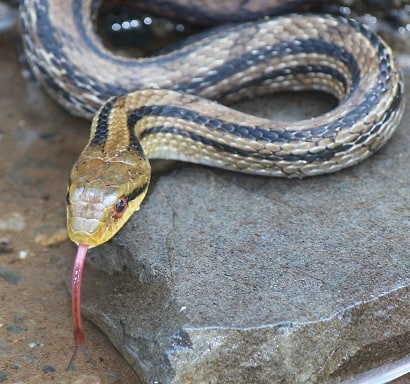
Tongue: pink in many shades.
Mainland Japan has two ratsnake species: the Japanese ratsnake (Elaphe climacophora), and the 4-lined version, which is simple to distinguish. This species lives on Honshu and Hokkaido, skipping only the southern Ryukyu islands such as Okinawa. They derive most of their calories from frogs, including montane brown frogs and tago’s brown frogs, but switch to lizards when none are available. Without their tongue, tracking down these succulent meals would be virtually impossible, and this tongue is a pink colour, with many varying shades. This matches the inside of their mouth, and differs to their eye, which is more bronze.
Japanese 4-lined snakes (Elaphe quadrivirgata) are clearly recognisable in Japan by their namesake 4 lines, which are dense black, contrasting against beige scales below. Their tongue also has a line through it – up close, a faint black runs through the pink. This species measures up to 200cm on certain islands, but is usually a far smaller 80-100cm.
Close relatives: the Korean ratsnake (Elaphe anomola) not far away has a black tongue, sometimes with red tinges. The four-lined snake of Italy (Elaphe quatuorlineata) also has a black tongue.
| 10 | Marbled tree snake |
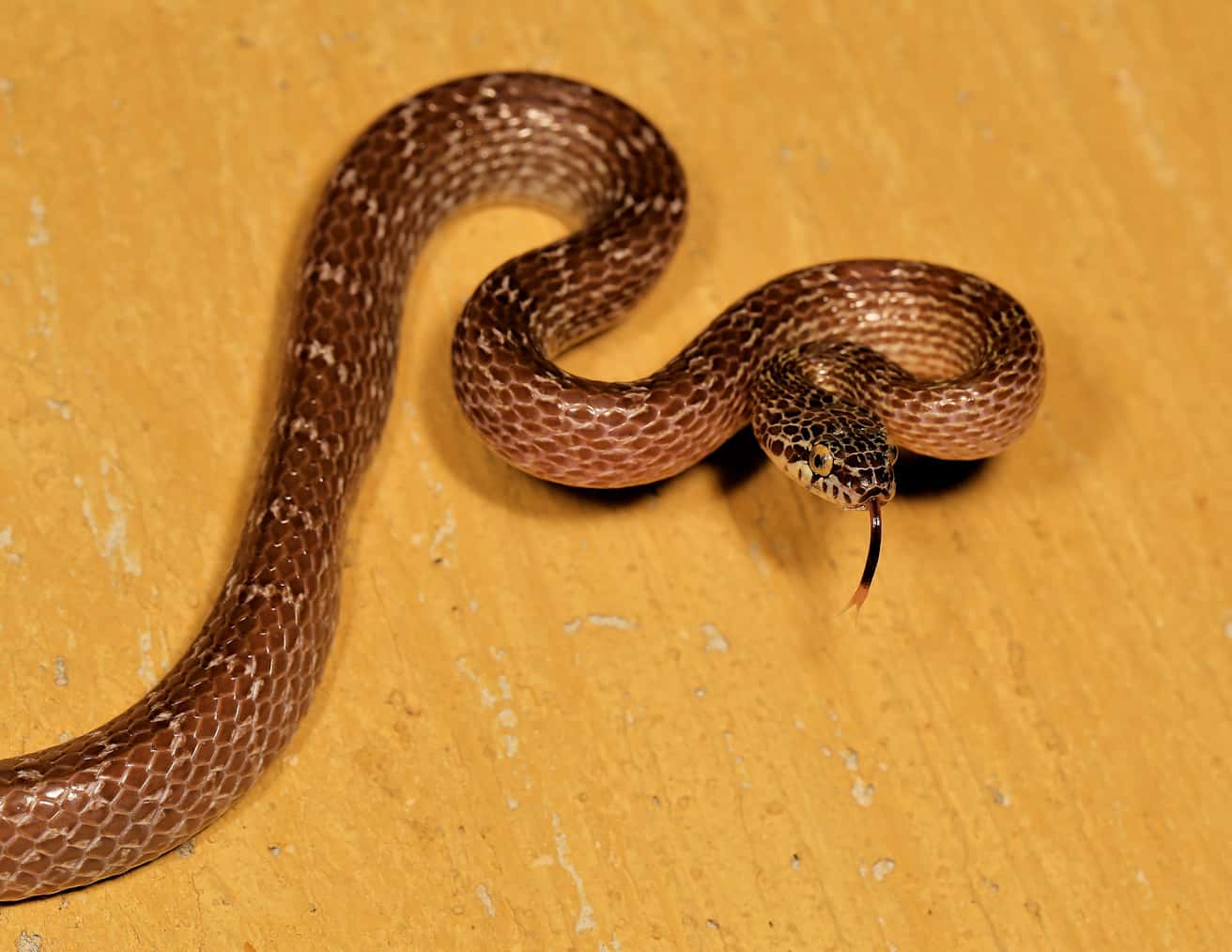
Tongue: very dark brown with a pink tip.
This 60cm (max 85cm) African snake has a very unusual tongue. Their bodies are purely dark brown and white, like a marbled cake from a supermarket. This is vaguely divided between a white belly and the main body, but the white intermingles with everything everywhere, like a black icing on a cake which is cracking to reveal the base underneath.
As for the tongue, its colours are a mere extension of the body, with a dark brown base, and a white tip at the very end. Only the orange eyes differ from the strict colour scheme.
This species preys on chameleons, such as Setaro’s dwarf chameleon. Marbled tree snakes are harmless to humans, but they apparently don’t realise it. When cornered, they’ll flatten their neck, gape their mouth open dementedly, and strike viciously yet harmlessly at the aggressor.
Marbled tree snakes inhabit Africa’s southeast, including South Africa, Zimbabwe, and Mozambique. Their favourite habitat of all is gallery forest on the edges of rivers or lakes. Lake Sibayi in Kwala Zulu-Natal is one of their confirmed bases.
Close relatives: its northerly relative Weiler’s tree snake (Dipsadoboa weileri) has a blue tongue. This species lives further north, roarming the wilds of Cameroon, DRC and Uganda.
